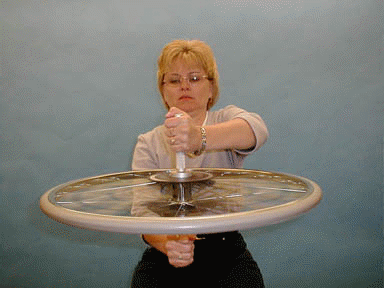 Conservation of Angular momentum:
The wheel is spun and then held with the axis vertical. The angular momentum vector is also in the vertical
direction. If the wheel is suddenly inverted, the turntable (chair that is free to rotate along with the lady) acquires an angular
momentum in the opposite direction, hence it is conserved.
Conservation of Angular momentum:
The wheel is spun and then held with the axis vertical. The angular momentum vector is also in the vertical
direction. If the wheel is suddenly inverted, the turntable (chair that is free to rotate along with the lady) acquires an angular
momentum in the opposite direction, hence it is conserved.
The rotational equivalent of momentum, is known as angular momentum.
For straight–line motion, momentum is given by p = mv. Momentum is a vector, pointing in the same direction as the velocity. Angular momentum has the symbol ‘L’, it can be represented by a vector, pointing in the direction of the angular velocity.
In the same way that linear momentum is always conserved when there is no net force acting, angular momentum is conserved when there is no net torque. If there is a net force, the momentum changes according to the impulse equation, and if there is a net torque the angular momentum changes according to a corresponding rotational impulse equation.
Angular momentum is proportional to the moment of inertia, which depends on not just the mass of a spinning object, but also on how that mass is distributed relative to the axis of rotation. This leads to some interesting effects, in terms of the conservation of angular momentum.
A good example is a spinning figure skater. Consider a figure skater who starts to spin with their arms extended. When the arms are pulled in close to the body, the skater spins faster because of conservation of angular momentum. Pulling the arms in close to the body lowers the moment of inertia of the skater, so the angular velocity must increase to keep the angular momentum constant.